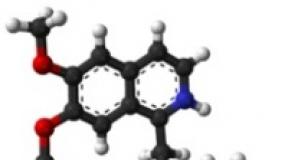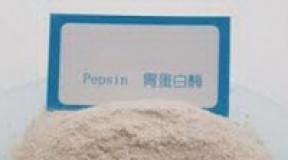Advantan emulsion - instructions for use. Fenistil Contraindications for use
Structure
1 g of emulsion contains:
Active ingredient - methylprednisolone aceponate 1 mg.
Excipients: medium chain triglycerides, softizan 378, macrogol-2-stearyl ether, macrogol-21-stearyl ether, glycerin 85% (E422), disodium edetate, benzyl alcohol, purified water.
Description
White opaque emulsion.
Pharmacotherapeutic group
Topical corticosteroids for the treatment of skin conditions. Highly active corticosteroids (group III)
ATX code D07AC14
Pharmacological properties"type \u003d" checkbox "\u003e
Pharmacological properties
Pharmacodynamics
When applied externally, Advantan
suppresses inflammatory and allergic skin reactions, as well as reactions associated with increased proliferation, which leads to a decrease in objective symptoms (erythema, edema, infiltration) and subjective sensations (itching, irritation, pain).
Methylprednisolone aceponate (especially its main metabolite, 6α-methylprednisolone-17-propionate) binds to intracellular glucocorticoid receptors. The steroid-receptor complex binds to specific regions of DNA, thus causing a series of biological effects.
In particular, the binding of the steroid-receptor complex to DNA leads to the induction of macrocortin synthesis. Macrocortin inhibits the release of arachidonic acid and thus the formation of inflammatory mediators such as prostaglandins and leukotrienes. The immunosuppressive effect of glucocorticoids can be explained by the inhibition of cytokine synthesis and the antimitotic effect, which is still insufficiently studied.
Inhibition by glucocorticoids of the synthesis of vasodilating prostaglandins and potentiation of the vasoconstrictor action of adrenaline lead to a vasoconstrictor effect.
Pharmacokinetics
Methylprednisolone aceponate penetrates the skin from the base dosage form... Its concentration decreases in the direction from the stratum corneum to the inner layers of the skin. Methylprednisolone aceponate is hydrolyzed in the epidermis and dermis. The main and most active metabolite is 6α-methylprednisolone-17-propionate, which binds more strongly to corticoid receptors of the skin in comparison with the original drug, which indicates the presence of its "bioactivation" in the skin.
The degree and intensity of percutaneous absorption depends on many factors, such as the chemical structure of the active substance, the composition of the base of the dosage form, the concentration of the active substance in the base of the dosage form, the conditions during application of the drug (area of \u200b\u200bapplication, duration of exposure, on an open skin area or under an occlusive dressing) and skin condition (type and severity of the disease, anatomical localization).
The intensity of absorption through the skin with artificial inflammation was very low (0.24% of the dose) and was slightly higher than through healthy skin (0.15%). Absorption through the skin with the removed stratum corneum was significantly higher (15%) than the dose. For whole body treatments (eg, sunburn), the systemic dose is about 2 mcg per kg of body weight per day, which excludes systemic effects.
After entering the systemic circulation, the product of the primary hydrolysis of 6α-methylprednisolone-17-propionate is rapidly conjugated with glucuronic acid and thus inactivated. Metabolites of methylprednisolone aceponate (the main of which is 6α-methylprednisolone-17-propionate-21-glucuronide) are eliminated mainly by the kidneys with a half-life of about 16 hours. After intravenous administration excretion in urine and feces was completed within 7 days. Methylprednisolone aceponate and its metabolites are not accumulated in the body.
Indications for use
Acute exogenous eczema (allergic contact dermatitis, irritant contact dermatitis, nummular eczema, dyshidrotic eczema, eczema vulgaris) and endogenous ( atopic dermatitis, neurodermatitis) from mild to moderate severity.
Contraindications
Hypersensitivity to drug components,
Tuberculous or syphilitic processes in the area of \u200b\u200bapplication of the drug,
Viral infections (for example, herpes or chickenpox),
Rosacea, perioral dermatitis, ulcers, acne, atrophic dermatitis and skin reactions to vaccinations,
Children under 4 months of age (due to insufficient experience of using),
Advantan emulsion should not be applied to eyes and deep open wounds,
Bacterial and fungal diseases skin (see "Precautions").
Method of administration and dosage
The drug is applied once a day with a thin layer on the affected skin, rubbing lightly. Usually, the course of treatment should not exceed 2 weeks in adults.
In case of seborrheic eczema with pronounced signs of inflammation, the drug should not be used for more than 1 week on the affected areas of the face.
If the skin dries excessively when using the Advantan emulsion, then, depending on the individual skin type, it is necessary to switch to a dosage form with a higher fat content (Advantan ointment) or apply an auxiliary basic therapy (water-oil emulsion, single-phase fatty ointment).
The patients childhood
Advantan is used in children from 4 months of age. No dose adjustment required.
The duration of treatment should be minimal.
Side effect"type \u003d" checkbox "\u003e
Side effect
Like all medicines, Advantan emulsion can cause side effects, although not everybody gets them.
When using Advantan emulsion with the greatest frequency (may occur in no more than 1 person in 10), local reactions such as burning were observed.
With a lesser frequency (may occur in no more than 1 person in 100), pain, blistering, itching, pustules, ulceration at the site of application, eczema, skin peeling, superficial cracks were observed.
Same as with other corticosteroids for local application, the following local undesirable reactions may occur (frequency is not known): skin atrophy, striae, folliculitis, erythema and dryness at the site of application of the drug, hypertrichosis, telangiectasia, perioral dermatitis, skin discoloration, acne and allergic skin reactions to any of the components of the dosage form. The systemic effects of corticosteroids can be observed when applied topically due to drug absorption.
Adverse reaction reporting
If you have any adverse reactions, consult your doctor. This recommendation applies to any possible adverse reactions, including those not listed in the package insert. You can also report adverse reactions to the Adverse Drug Reaction (s) Information Database, including reports of drug ineffectiveness. By reporting adverse reactions, you can help provide more information on the safety of this medicine.
medicines"type \u003d" checkbox "\u003e
Interaction with other medicinal products
Due to absorption, treatment of large areas of skin or prolonged treatment can lead to interactions that are possible with systemic therapy. To date, no cases are known.
Overdose
In the acute toxicity study of methylprednisolone aceponate, no risk was identified acute intoxication with excessive single skin use (application of the drug over a large area under conditions favorable for absorption) or unintentional ingestion.
Precautions
Glucocorticoids should be used in as low a dose as possible, especially in children and only as long as absolutely necessary to achieve and maintain a therapeutic effect.
In the presence of bacterial dermatoses and / or dermatomycosis, in addition to Advantan therapy, specific antibacterial or antimycotic treatment should be carried out.
Local skin infections can be aggravated by the use of topical glucocorticoids.
Avoid contact with the eyes, deep open wounds and mucous membranes.
Advantan emulsion should not be applied under an occlusive dressing. It should be borne in mind that diapers can create an occlusive effect.
The application of excessive amounts of topical corticosteroids to large areas of the skin or for a long time, especially under an occlusive dressing, can significantly increase the risk of developing side emulsions. It should not be applied on large surfaces (more than 40% of the body surface). Advantan emulsion should not be applied to the diaper rash area.
When treating large skin surfaces, especially during pregnancy and lactation, the duration of treatment should be minimal, since the possibility of absorption or systemic effects cannot be excluded.
For the treatment of skin diseases accompanied by bacterial and / or fungal infections, special therapy is required.
As with systemic corticosteroids, glaucoma may develop after topical corticosteroid use (for example, after high doses, or very long-term use, using occlusive dressings, or applying to the skin around the eyes).
The drug is not recommended for use in children under 4 months of age. It is necessary to assess the risk-benefit when used in children from 4 months of age to 3 years.
Part ointment Advantan the active substance is included in a concentration of 1 mg / g. White wax, soft white paraffin, purified water are used as auxiliary components, , degimuls E (Dehymuls E).
As part of oily ointment for external use present at a concentration of 1 mg / g, liquid paraffin, soft white paraffin, microcrystalline wax, castor oil hydrogenated.
Structure cream: methylprednisolone aceponate at a concentration of 1 mg / g, decyloleate, cetostearyl alcohol, glycerol monostearate 40-55%, softizan 378, solid fat, polyoxyl stearate 40, sodium edetate, glycerin 85%, benzyl alcohol, butyl hydroxytoluene, purified water.
Structure emulsions Advantan: methylprednisolone aceponate at a concentration of 1 mg / g, medium-chain triglycerides, polyoxyethylene-2- and polyoxyethylene-21-stearyl alcohol, softizan 378, glycerin 85%, sodium edetate, benzyl alcohol, purified water.
Release form
Dosage forms of Advantan:
- ointment 0.1% (tubes 15 g);
- fatty ointment 0.1% (tubes 5 and 15 g);
- cream 0.1% (tubes 5 and 15 g);
- skin emulsion 0.1% (tubes 10, 20 and 50 g).
Ointment 0.1% is a white or slightly yellowish homogeneous opaque mass. Greasy ointment 0.1% - translucent, white or white with a slightly yellowish tinge. Cream 0.1% for external use white or slightly yellowish, opaque. Emulsion Is an opaque white substance.
pharmachologic effect
The medicine belongs to the group GCS drugs which are used as external therapy .
Pharmacodynamics and pharmacokinetics
The active component of Advantan is a synthetic non-halogen-substituted corticosteroid molecule, a feature of which is an increased degree of dissociation (separation) during the implementation of its effects (both local and systemic).
For external use stops inflammatory process , suppresses allergic and proliferation-related reactions, which helps to reduce objective symptoms and subjective sensations.
Repeated application of the drug to large areas of the skin (from 40 to 60% of the body surface), as well as its application under an occlusive dressing, does not cause disturbances functional state adrenal glands : plasma concentration cortisol and circadian rhythm remain within the physiological norm at a constant level in daily urine.
The main metabolite of methylprednisolone aceponate binds to those localized inside the cell glucocorticoid receptors ... The steroid-receptor complex, in turn, binds to individual sites DNA and thus causes biological effectsincluding induction of synthesis macrocortin and suppression of the formation of inflammatory mediators type l eucotrienes and prostaglandins .
The degree of absorption through the skin depends on the condition of the skin, the method of application and the dosage form of Advantan. When using ointments and creams, the percutaneous absorption rates in patients did not exceed 2.5% (in healthy volunteers, this indicator is usually in the range of 0.5-1.5%).
When using the methylprednisolone emulsion, aceponate is absorbed through the skin in extremely small quantities (the absorption rate is about 0.27% in people with skin diseases and 0.17% in healthy volunteers). Even in the case of treating the skin of the whole body, the systemic dose is so small that the likelihood of developing systemic effects is excluded.
Advantan undergoes hydrolysis in the epidermal layer and dermis. The excretion of metabolic products of methylprednisolone aceponate is carried out mainly kidneys , the half-life is about 16 hours.
Indications for use
Indications for the use of Advantan ointment, oily ointment and cream
The use of these agents is advisable for the treatment of topical glucocorticoids sensitive to therapy. inflammatory skin diseases .
Answering the questions “ What is Advantan ointment from?" or " What is the cream used for?”, The manufacturer indicates that methylprednisolone aceponate in these dosage forms is effective for:
- neurodermatitis ;
- child, microbial, professional, dyshidrotic and true ;
- (simple contact or allergic contact).
Indications for use emulsions
The emulsion has the same indications for use as all other forms of Advantan. In addition, it can be used when photodermatitis , as well as to eliminate the consequences sunburn .
Contraindications
You should not prescribe Advantan when:
- the presence of manifestations on the skin in the area of \u200b\u200bapplication of the product;
- tuberculosis of the skin ;
- viral skin diseases with localization of lesions in the area of \u200b\u200bapplication of a cream, ointment or emulsion (for example, when herpes zoster or chickenpox );
- perioral dermatitis or rosacea in the field of drug application;
- skin reactions to the vaccine;
- hypersensitivity to the components of the drug.
In pediatrics, the drug is used to treat children over 4 months of age.
Side effects
As a rule, Advantan is well tolerated and rarely causes certain side effects.
Sometimes (no more than in 0.01% of cases) local reactions may occur, manifested in the form of a burning sensation, itchy skin, erythema, appearance of vesicular rash. Long-term (more than 4 weeks) use, as well as application on skin areas that make up more than 10% of the total body area, can provoke:
- atrophy of the skin ;
- appearance striae and telangiectasias ;
- acneform skin changes ;
- a number of systemic effects associated with the absorption of methylprednisolone aceponate.
However, in the course of the studies conducted, none of the above symptoms was detected either in adults who were treated with Advantan for up to 12 weeks, or in children (including children early age), in whom the drug was used for up to 4 weeks.
In 0.01-1% of patients, the use of Advantan is accompanied by: perioral dermatitis , folliculitis , depigmentation of the skin , hypertrichosis , allergic reactions due to individual sensitivity to any of the substances included in the preparation.
Instructions for the use of Advantan
Advantan is intended for the treatment of patients of all age groups, starting from the age of four months. Both cream and ointment should be applied to the affected skin in a thin layer once a day.
AND ointmentand cream Advantan for children can be used continuously for no more than 4 weeks, for adults - no more than 12 weeks
Duration of application course emulsionsis usually no more than 14 days.
Ointment Advantan: instructions for use
Ointment is a dosage form in which fat and water are present in equal proportions. In this regard, the ointment is recommended for use with inflammatory skin diseasesthat proceed in subacute or chronic form and are not accompanied by oozing.
The therapeutic effect of the ointment is also aimed at eliminating dryness and restoring the physiological parameters of the oily skin.
Fatty ointment is an anhydrous dosage form of Advantan, therefore its use is advisable for treatment dermatological diseases , which have a chronic inflammatory nature and exist in the patient for a long period of time. Greasy ointment is most effective in patients with very dry skin.
By creating an occlusive effect, the ointment provides a pronounced therapeutic effect even with significant infiltration and lichenization the skin.
Advantan cream: instructions for use
Advantan cream is a substance with a high water content and a low fat content. The use of this dosage form is indicated for the treatment of inflammatory processes that occur in an acute or subacute form and are not accompanied by pronounced weeping.
The use of the cream allows you to stop the inflammatory process, both on smooth areas of the skin and on hairy ones, including on the skin, which is prone to oily.
Emulsion Advantan: instructions for use
For skin lesions caused by overexposure ultraviolet radiation, the agent is used once or twice a day. If the use of the emulsion is accompanied by increased dryness of the skin, it is necessary to switch to the use of ointments or fatty ointments, in which the percentage of the active substance is higher.
Overdose
In the course of studies, the purpose of which was to study the acute toxicity of Advantan, no risk of acute intoxication was established, both with a single external application of the drug in an excessively high dose, and with its accidental ingestion.
Excessively long treatment glucocorticosteroids , as well as intensive local application of these funds, can cause thinning and atrophy of the skin, the appearance striae and telangiectasias .
Treatment involves discontinuation of the drug.
Interaction
The drug interaction of Advantan has not been established.
Terms of sale
It is used as a non-prescription drug.
Storage conditions
Optimum storage temperature ointments, emulsions and cream is the temperature not exceeding 25 degrees Celsius. Greasy ointment it is recommended to store at temperatures up to 30 degrees Celsius. Medications Advantan must be kept out of the reach of children.
Shelf life
The ointment, emulsion and cream are considered usable for 3 years. The shelf life for oily ointment is 5 years.
special instructions
Neither methylprednisolone aceponate nor its metabolic products accumulate in the body.
When dermatoses and d ermatomycosis of bacterial genesis Advantan therapy is supplemented by the appointment of specific antimycotic or antibacterial agents .
Avoid getting the drug in the eyes.
External therapy with application glucocorticosteroids , as well as systemic, can cause development. The pathological process is usually provoked by long-term treatment, the use of the drug under an occlusive dressing to treat the skin around the eyes, treatment with high doses of methylprednisolone aceponate.
Analogs of Advantan
Matching ATX level 4:Advantan's analogs are drugs Monovo , Synoderm , Betlieben .
Under the indicated names, both cream analogues and ointment substitutes are produced.
The price of ointment analogues is from 105 Russian rubles.
Which is better - Advantan or Elokom?
Advantan and Elokom Are analogous drugs. The first is based on methylprednisolone , the composition of the second as an active substance includes mometosone furoate .
Methylprednisolone enters the systemic circulation in smaller quantities than mometosone and is considered safer for use in pediatrics.
Mometosone is well absorbed by the body through the skin, which can provoke quite serious side effects in a child (muscle weakness, weight gain, edema, etc.), as well as, in the case of long-term use, growth retardation.
Unlike Advantan, which is allowed to be prescribed even to 4-month-old children, Elokom shown only from 2 years of age.
For children
For children, Advantan is prescribed for allergic and inflammatory skin diseases .
Advantan for infants and older children is prescribed in the form ointments or cream, since the exact data on the safety of use emulsions as of today, no.
Often mothers have questions “ Is Advantan ointment hormonal or not?" or " Is the cream hormonal or not?”. The active substance of Advantan - methylprednisolone - synthetic glucocorticosteroid , that is, the drug is hormonal .
Since the medicine contains hormones, it should be prescribed very carefully (this is especially true for infants). However, in the presence of severe clinical symptoms , the remedy can be recommended as early as four months of age.
In accordance with the instructions, both cream and ointment in a child can be used for no more than 4 weeks. The medicine should be applied to the skin once a day.
Prescribing to the child topical glucorticoid (HA) for external use, doctors usually adhere to the following rules:
- apply the indicated means taking into account the biorhythms of children (so that the GC imitates the daily rhythm of the function adrenal cortex , use the drug in the morning);
- use an individual approach to each child, taking into account the extent of skin lesions, age, severity of the process, clinical form diseases, the duration of previous treatment with the use of similar drugs, etc.;
- change concentration hormones in a dosage form, diluting it in various ratios with indifferent creams (for babies, dermatologists are often advised to dilute the drug with baby cream or petroleum jelly in a ratio of 1:10, the optimal proportion for children under three years old is 1: 7, for children three to five years old - 1: 4, for children 5-10 years old - 1: 3, for children over 10 years old - 1: 1);
- external therapy with HA drugs is complemented by other types of local and systemic treatment
Advantan at diathesis in children and others allergic skin reactions effective even with a critical condition of the skin. However, it should be borne in mind that a very small child, as well as in the presence of significant skin lesions, is recommended to apply it very carefully, since methylprednisolone , absorbed through the skin into the systemic circulation, can provoke side effects .
The drug is hormonal, so they need to stop treatment gradually.
Which is better - cream or ointment?
The choice of the dosage form is determined by the condition of the skin: with dry skin, the optimal choice is greasy ointment; with normal skin (not dry, and without weeping elements of the rash) - ointment; for diseases characterized by oozing , doctors recommend using cream, and for the treatment of sunburn and photodermatitis best to use emulsion.
Advantan during pregnancy
If it is necessary to prescribe the drug Advantan to pregnant and lactating women, it is recommended to weigh the expected benefits for the maternal body and the risks for the developing fetus or nursing infant.
During pregnancy and lactation, the drug should not be used for a long time on large surfaces of the body. Breastfeeding women are advised not to apply ointment, cream, or emulsion to the breast skin.
Instructions for medical use
drug
Advantan ®
Tradename
Advantan ®
International non-proprietary name
Methylprednisolone aceponate
Dosage form
Emulsion 0.1%
Structure
1 g of emulsion contains
active substance - methylprednisolone aceponate 1.00 mg
excipients:medium chain triglycerides, Softizan 378, polyoxyethylene-2-stearyl alcohol, polyoxyethylene-21-stearyl alcohol, benzyl alcohol, sodium edetate, glycerin 85%, purified water.
Description
White opaque emulsion
Pharmacotherapeutic group
Glucocorticosteroids for topical treatment of skin diseases.
Active glucocorticosteroids (Group III). Methylprednisolone aceponate.
ATX code D07AC14
Pharmacological properties
Pharmacokinetics
Methylprednisolone aceponate penetrates the skin from the base of the dosage form. Its concentration decreases in the direction from the stratum corneum to the inner layers of the skin.
Methylprednisolone aceponate is hydrolyzed in the epidermis and dermis. The main and most active metabolite is 6α-methylprednisolone-17-propionate, which binds more strongly to corticoid receptors of the skin in comparison with the original drug, which indicates the presence of its "bioactivation" in the skin.
The degree and intensity of percutaneous absorption depends on many factors, such as the chemical structure of the active substance, the composition of the base of the dosage form, the concentration of the active substance in the base of the dosage form, conditions during application of the drug (area of \u200b\u200bapplication, duration of exposure, on an open skin area or under an occlusive dressing) and skin condition (type and severity of the disease, anatomical localization).
To study the transdermal absorption of methylprednisolone aceponate from the emulsion base, the skin condition was artificially changed.
Healthy skin was compared to skin with artificial inflammation (with ultraviolet erythema) and skin with artificial damage (with removed stratum corneum).
The intensity of absorption through the skin with artificial inflammation was very low (0.24% of the dose) and was slightly higher than through healthy skin (0.15% of the dose). Absorption through the skin with the removed stratum corneum was significantly higher (15%) than the dose.
With inflamed skin, in the case of treatment of the whole body with Advantan emulsion, 20 g 2 times a day, the systemic load is about 2 μg of metiprednisolone aceponate per 1 kg of body weight per day.
After entering the systemic circulation, the product of the primary hydrolysis of 6α-methylprednisolone-17-propionate is rapidly conjugated with glucuronic acid, and thus is inactivated. Metabolites of methylprednisolone aceponate (the main of which is 6α-methylprednisolone-17-propionate-21-glucuronide) are eliminated mainly by the kidneys with a half-life of about 16 hours. After intravenous administration, urinary and fecal excretion was complete within 7 days. Methylprednisolone aceponate and its metabolites are not accumulated in the body.
Pharmacodynamics
When applied externally, Advantan® emulsion suppresses inflammatory and allergic skin reactions, as well as reactions associated with increased proliferation, which leads to a decrease in objective symptoms (erythema, edema, infiltration) and subjective sensations (itching, burning, pain).
Methylprednisolone aceponate (especially its main metabolite, 6α-methylprednisolone-17-propionate) binds to intracellular glucocorticoid receptors.
The steroid-receptor complex binds to specific regions of DNA, thus causing a series of biological effects.
In particular, the binding of the steroid-receptor complex to DNA leads to the induction of macrocortin synthesis. Macrocortin inhibits the release of arachidonic acid and thus the formation of inflammatory mediators such as prostaglandins and leukotrienes.
The immunosuppressive effect of glucocorticoids can be explained by inhibition of cytokine synthesis and an antimitotic effect, which is still insufficiently studied.
Inhibition by glucocorticoids of the synthesis of vasodilating prostaglandins or potentiation of the vasoconstrictor action of adrenaline ultimately lead to a vasoconstrictor effect.
Indications for use
Acute exogenous eczema (allergic contact dermatitis, toxic degenerative eczema, numular eczema (microbial eczema), dyshidrotic eczema)
Atopic dermatitis (neurodermatitis)
Seborrheic eczema
Gravitational eczema
Solar dermatitis (severe sunburn)
Eczema of unknown etiology
Advantan® emulsion is indicated for the treatment of children from 4 months.
Method of administration and dosage
Advantan® emulsion is used for topical application. The drug is applied once a day with a thin layer on the affected skin and rubbed lightly.
As a rule, the duration of treatment with Advantan ® should not exceed 2 weeks.
If the skin is excessively dry when using the Advantan® emulsion, which depends on the individual characteristics of the skin, additional neutral therapy (oil-water emulsion or single-phase fatty ointment) is recommended as a means to soften the skin.
Pediatric patients
Dose adjustment is not required when prescribing Advantan® emulsion to children aged 4 months and older, as well as adolescents.
Side effects
The most frequent were such adverse reactions, like a burning sensation at the site of application of the drug.
Often (\u003e 1/100,<1/10)
Burning sensation at the site of application
Infrequently (\u003e 1/1000,<1/100)
Pain, blistering, itching, pustules, erosion at the site of application
Eczema, flaking and cracked skin
As well as with other topical corticosteroids, the following local adverse reactions may occur:
- skin atrophy, dryness, erythema, striae, folliculitis at the site of application of the drug, hypertrichosis, telangiectasia, perioral dermatitis, skin discoloration, acne and / or allergic skin reactions to any of the components of the dosage form. The systemic effects of corticosteroids can be observed when applied topically due to drug absorption.
Contraindications
Tuberculous or syphilitic processes in the area of \u200b\u200bdrug application
Viral diseases (eg, chickenpox, shingles) in the area of \u200b\u200bapplication
Rosacea, perioral dermatitis, ulcers, acne, atrophic skin diseases, post-vaccination skin reactions in the area of \u200b\u200bdrug application
Hypersensitivity to the active substance or to any of the excipients of the drug
Drug interactions
Not installed
special instructions
In the presence of bacterial dermatoses and / or dermatomycosis, in addition to Advantan ® therapy, specific antibacterial or antimycotic treatment should be carried out.
When using Advantan® emulsion, care should be taken to avoid getting the drug in the eyes, deep open wounds and mucous membranes.
When Advantan ® fatty ointment 0.1% is used in children on large surfaces (40-90% of the skin surface) in the absence of an occlusive dressing, there are no adrenal dysfunctions.
When Advantan ® ointment 0.1% was applied on 60% of the skin surface for 22 hours under an occlusive dressing, suppression of plasma cortisol levels and an effect on the circadian rhythm were observed in healthy adult volunteers.
Emulsion Advantan ® should not be applied under an occlusive dressing. Should have in mind that diapers (diapers) can create an occlusive effect. This is especially important since the Advantan emulsion ® not recommended for use in children under 4 months of age. As with systemic corticosteroids, it may develop
glaucoma when using topical corticosteroids (for example, after high doses, or with extensive application of the drug for a long time, using occlusive dressings or applying the drug to the skin around the eyes).
Pregnancy and lactation
Pregnancy
There are no adequate data on the use of the drug during pregnancy.
In general, the use of topical preparations containing corticosteroids should be avoided during the first trimester of pregnancy. In particular, during pregnancy, you should avoid applying the drug to large areas of the skin, prolonged use or application under an occlusive dressing.
There are epidemiological data indicating a possible increased risk of developing palatal obstruction in newborns whose mothers received glucocorticoid treatment during the first trimester of pregnancy.
When there is a clinical indication for the treatment of Advantan ® emulsion during pregnancy, the potential risk and the expected benefit of treatment should be carefully weighed.
Lactation
It is not known whether methylprednisolone aceponate is excreted in breast milk as systemic corticosteroids, which can be reported to be secreted in breast milk.
It is not known whether topical application of the Advantan® emulsion can lead to sufficient systemic absorption of metiprednisolone aceponate, sufficient to be detected in breast milk.
Therefore, care should be taken when prescribing the drug to lactating women.
In nursing mothers, the drug should not be applied to the mammary glands. Avoid applying the drug to large skin surfaces, prolonged use or applying under an occlusive dressing during lactation.
Application in pediatric practice
Advantan ® can be used in children from 4 months of age. The safety of Advantan® emulsion has not been studied in children under 4 months of age. There are no data on the use of the drug in children in this group.
Features of the effect of the drug on the ability to drive a car or potentially dangerous machinery.
Does not affect
Overdose
When studying the acute toxicity of methylprednisolone aceponate, there was no risk of acute intoxication with excessive single skin use (application of the drug over a large area under conditions favorable for absorption) or unintentional ingestion.
Release form and packaging
20 g of the drug in tubes, sealed with plastic
lids. 1 tube together with instructions for use in the state Russian language is put into a cardboard box.
Storage conditions
Store at a temperature not exceeding 25 ° C.
Keep out of the reach of children!
Storage period
Do not use after the expiration date.
Terms of dispensing from pharmacies
On prescription
Manufacturer
Bayer Healthcare Manufacturing S.r.l., Segrate, Italy
Marketing Authorization Holder
Bayer Pharma AG, Berlin, Germany
The address of the organization that accepts claims from consumers on the quality of the product (goods) on the territory of the Republic of Kazakhstan:
Bayer KAZ LLP
st. Timiryazeva, 42, business center "Expo-City", pav. 15
050057 Almaty, Republic of Kazakhstan,
tel. +7 727 258 80 40, fax: +7 727 258 80 39, e-mail: [email protected]
Did you get sick leave for back pain?
How often do you experience back pain?
Can you tolerate pain without taking pain relievers?
Learn more about managing back pain as quickly as possible
1 g of the emulsion contains 1 mg (0.1%) methylprednisolone aceponate.
Release form:
Emulsion 20 g in an aluminum tube in a cardboard box.
The emulsion is white, opaque.
Pharmachologic effect:
Glucocorticosteroid (GCS) for topical use.
Indication for use:
Inflammatory skin diseases sensitive to topical GCS therapy:
- atopic dermatitis, neurodermatitis, childhood eczema;
- simple contact dermatitis;
- allergic (contact) dermatitis;
- true eczema;
- seborrheic dermatitis / eczema;
- microbial eczema;
- photodermatitis, sunburn.
Method of administration and dosage:
For adults and children from 4 months, the drug is applied once a day with a thin layer on the affected skin.
The course of treatment with Advantan in the form of an emulsion is usually no more than 2 weeks.
The emulsion is applied to the skin in a thin layer, rubbing lightly. For sunburn, the emulsion is used 1-2 times a day. If the skin dries excessively when using the emulsion, it is necessary to switch to a dosage form of Advantan with a higher fat content (ointment or fatty ointment).
Contraindications:
- tuberculosis of the skin and skin manifestations of syphilis in the area of \u200b\u200bapplication of the drug;
- viral skin lesions in the area of \u200b\u200bapplication of the drug (for example, with chickenpox, shingles);
- rosacea, perioral dermatitis in the area of \u200b\u200bapplication of the drug;
- skin manifestations of a reaction to vaccination;
- children's age up to 4 months;
- hypersensitivity to drug components.
Special instructions:
In the presence of bacterial dermatoses and / or dermatomycosis, in addition to Advantan therapy, specific antibacterial or antifungal treatment should be carried out.
Avoid getting the drug in the eyes.
As with the use of systemic corticosteroids, with external use of GCS, glaucoma may develop (for example, after high doses or very long-term use, the use of occlusive dressings or application to the skin around the eyes).
Influence on the ability to drive vehicles and control mechanisms: not found.
Storage conditions:
The emulsion should be stored at a temperature not exceeding 25 ° C out of the reach of children. The shelf life is 3 years.
Note:
The drug is approved for use as a means of OTC.
Emulsion for external use 0.1% white, opaque
Structure
methylprednisolone aceponate 1 mg
Excipients: triglycerides with medium chains, softizan 378, polyoxyethylene-2-steryl alcohol, polyoxyethylene-21-steril alcohol, glycerol 85%, benzyl alcohol, sodium edetate, purified water.
Pharmacodynamics
GCS for external use is a non-halogenated synthetic steroid. When applied externally, Advantan suppresses inflammatory and allergic skin reactions, as well as reactions associated with increased proliferation, which leads to a decrease in objective symptoms (erythema, edema, lichenification) and subjective sensations (itching, irritation, pain).
When methylprednisolone aceponate is used, the externally systemic effect is minimally expressed in both humans and animals. After repeated application of Advantan to large surfaces (40-60% of the skin surface), as well as when applied under an occlusive dressing, there are no adrenal dysfunctions in either children or adults: the level of cortisol in the blood plasma and its circadian rhythm remain within normal limits, there is no decrease in cortisol levels in daily urine.
In the course of clinical studies, when using Advantan in the form of an ointment, cream or oily ointment for up to 12 weeks in adults and up to 4 weeks in children (including young children), no development of skin atrophy, telangiectasias, striae and acne-like rashes was revealed.
Methylprednisolone aceponate (especially its main metabolite, 6alpha-methylprednisolone-17-propionate) binds to intracellular glucocorticoid receptors. The steroid-receptor complex binds to specific regions of DNA, thus causing a series of biological effects.
In particular, the binding of the steroid-receptor complex to DNA leads to the induction of macrocortin synthesis. Macrocortin inhibits the release of arachidonic acid and thus the formation of an inflammatory mediator such as prostaglandins and leukotrienes.
Inhibition of the synthesis of vasodilating prostaglandins by GCS and the potentiation of the vasoconstrictor action of adrenaline leads to a vasoconstrictor effect.
Pharmacokinetics
Suction
The intensity of absorption through the skin depends on the condition of the skin, the dosage form and the method of application (on an open skin area or under an occlusive dressing). When using an ointment, cream or fatty ointment, percutaneous absorption in adolescents and adults with neurodermatitis and psoriasis was less than 2.5%, which only slightly differed from absorption through intact skin in healthy adult volunteers (0.5-1.5%).
When using the drug in the form of an emulsion, absorption through the skin with artificial inflammation was very low (0.27%) and slightly exceeded absorption through healthy skin (0.17%). Absorption through the skin with the removed stratum corneum was significantly higher (15% of the dose).
In the case of a whole body treatment (eg, for sunburn), the systemic dose is about 4 μg / kg bw / (which excludes systemic effects).
Metabolism and excretion
Methylprednisolone aceponate is hydrolyzed in the epidermis and dermis. The main and most active metabolite is 6alpha-methylprednisolone-17-propionate, which has a significantly higher affinity for corticoid receptors in the skin, which indicates the presence of its bioactivation in the skin.
After entering the systemic circulation, 6alpha-methylprednisolone-17-propionate is rapidly conjugated with glucuronic acid and thus inactivated.
Metabolites of methylprednisolone aceponate (the main of which is 6alpha-methylprednisolone-17-propionate-21-glucuronide) are excreted mainly by the kidneys, with a half-life of about 16 hours.
Methylprednisolone aceponate and its metabolites do not accumulate in the body.
Side effects
In isolated cases: itching, burning, erythema, blistering at the site of application of the drug.
Rarely: as with the use of other corticosteroids - folliculitis, hypetrichosis, perioral dermatitis, allergic reactions.
Selling features
Available without a prescription
Special conditions
In the presence of bacterial dermatoses and / or dermatomycosis, in addition to Advantan therapy, specific antibacterial or antifungal treatment should be carried out.
The emulsion should not be applied under an occlusive dressing. It must be borne in mind that diapers (diapers) can create an occlusive effect.
Avoid getting the drug in the eyes.
As with the use of systemic corticosteroids, with external use of GCS, glaucoma may develop (for example, after high doses or very long-term use, the use of occlusive dressings or application to the skin around the eyes).
Influence on the ability to drive vehicles and use mechanisms
Does not affect the ability to drive vehicles and work with mechanisms.
Indications
Acute inflammatory skin diseases in adults and children aged 4 months and older:
Atopic dermatitis, neurodermatitis;
Contact dermatitis;
True eczema;
Seborrheic eczema;
Microbial eczema;
Dyshidrotic eczema;
Degenerative eczema;
Solar dermatitis (severe sunburn).
Contraindications
Tuberculosis of the skin and skin manifestations of syphilis in the area of \u200b\u200bapplication of the drug;
Viral skin lesions in the area of \u200b\u200bapplication of the drug (for example, with chickenpox, shingles);
Rosacea, perioral dermatitis in the area of \u200b\u200bdrug application;
Skin manifestations of a reaction to vaccination;
Hypersensitivity to drug components.
Drug interactions
Drug interaction of the drug Advantan is not described



















